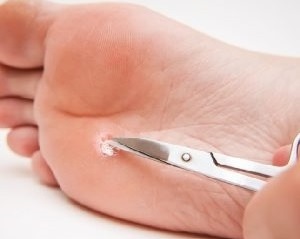Not only is wart an unpleasant skin defect, but it is also a complex disease that requires complex treatment. The root cause of papillomas is the proliferation of dormant virus in the human body. Laser wart removal is a modern safe method. It is used worldwide: fast healing and the least risk of recurrence allows you to remove warts in children and adults without consequences.
A modern method of removing warts
Reduced immunity is a prerequisite for the appearance of warts. The growths grow rapidly and can form complete clusters. You can become infected with the papilloma virus - the root cause of the disease - through contact with a sick person or through personal property. Whatever the cause of the appearance of warts, they need to be treated. The first step of comprehensive treatment is to remove all formations on the skin.
Modern methods of excluding warts include radio wave and laser removal. Laser eradication of the neoplasm on the skin is the simplest and painless procedure that guarantees a stable result. Minor operation is performed using local anesthesia and without additional long-term preparation. The erection is done sensitively in a specialized office and only by an experienced doctor. The stages of the procedure and the qualifications of the doctor are a guarantee that there will be no recurrence of the disease soon.
What type of warts are removed by a laser?
Papillomas can differ in appearance and location on the human body. Warts affect the arms, legs, back and face of adults and children. There are no age restrictions on patients with papillomatosis. With the help of laser therapy, plantar warts can be removed. These are neoplasms of the leg that develop in the horny part of the skin. Laying, the dead skin turns into a seal with a clear visible heart in the center.
The laser is used to remove common warts: growth of a compact, round structure. Such warts are different in skin color (they are much darker). Over time, common warts increase in size and make a person angry: they cause great discomfort and occasional injuries.
Laser therapy is used to remove flat warts. The size of the small configurations does not exceed 1 cm. The growths have a flat structure and from the side they look like skin colored nodules. Flat warts do not rise far above the skin and rarely cause discomfort in a person. Before a laser technique is prescribed to remove an erection, an accurate diagnosis is determined - the wart and its type are examined.
Advantages of the procedure

During the initial examination, it is necessary to determine the status of the neoplasm. If it does not have cancer, it can be removed by modern methods. If we talk about warts on the legs, they are removed in several stages - rods often grow in soft tissues. Warts on the feet are always painful and create discomfort while walking. With the help of the laser method alone, such warts are removed in one step, allowing you to recover quickly after the procedure.
Root callus is difficult to remove without subsequent relapse: simple surgical excision is ineffective. Laser therapy helps to destroy all infected cells with the virus, even those that are not visible to the naked eye.
The benefits of laser therapy include: speed of procedure and speed of recovery. In total, the growth takes no more than half an hour, depending on the complexity of the neoplasm and the number of warts. The minimum number of contraindications makes laser therapy universal and safe for children. He is allowed to perform the procedure from the age of 5.
Pain relief is the ideal procedure for people with hypersensitivity: a small amount of medication and pain relief is used to remove the wart.
After laser therapy, scars or hard scars almost do not remain on the affected skin area. The main advantages of the rapid recovery procedure and low probability of complications are complications compared to other modern techniques. The innovative equipment allows minor operation to be performed without perceived discomfort to the patient. The patient is rehabilitated at home in his normal conditions.
Contraindications to this procedure
The effective technique has several contraindications. In preparation for minor surgery, the patient undergoes a complete examination of the body. Based on the results obtained, the attending physician evaluates additional treatments and risks to the patient.
Contraindications to laser therapy:- skin rash
- and herpes; advanced dermatitis
- ; high blood pressure
- ;
- acute respiratory diseases (the patient has a weakened immune system after a previous illness);
- malignant diseases.

A pregnant woman should refuse the procedure: if possible, laser therapy is postponed until the postpartum period. If a rash of unknown origin appears on the human body, the removal of the warts needs to be postponed. Systemic diseases are direct contraindications to minor surgery.
Thyroid diseases prevent the use of a laser beam to remove an unpleasant wart. Allergy to the sun is a rare disease that does not allow the laser procedure: in such cases, the fight against warts is carried out by using radio wave therapy.
Severe renal and hepatic impairment is a contraindication to minor surgery. Before using modern techniques, it is necessary to take into account all the violations that can cause serious complications in an adult or a child.
How the procedure is performed
The procedure is performed under sterile conditions. Previously, the patient undergoes blood and urine tests. Based on the results obtained, the type of anesthesia used and the pain medications required during laser therapy are determined. The non-invasive method does not involve any contact with the skin: the person sits on a comfortable sofa in a lying or sitting position. A drug is injected on the side of the wart, which should reduce any pain.
After 5-10 minutes, the injectable drug takes effect. The laser beam affects the build-up for a few minutes. After the procedure, the affected area of the skin is treated with special methods and a bandage is applied.
A half-hour operation does not require hospitalization: immediately after laser therapy, the patient goes home alone.
Skin treatments and restorations are done at home. During the procedure, the possibility of bleeding is completely excluded. If the skin is not cut, infections or pathogenic microorganisms cannot enter the wound - postoperative secondary infection is excluded.
Recovery after laser removal
Healing of the skin area affected by a wart depends directly on the procedure performed. The high-tech laser is completely sterile (bactericidal). It works on the skin and does not cause inflammation - for this reason, no visible scars or scars are left on the body. The pathogen of the bacteria or viruses was completely destroyed on the laser-treated area. Immediately after the procedure, you may feel a slight discomfort under the bandage, which will soon disappear.
The skin is completely regenerated within 2 weeks (up to a month in people with weakened immunity). A hard crust forms on the treated area: healing occurs under it. As soon as the lower skin heals, the crust falls off without further damage.
The crust lasts about 10 days and does not cause any discomfort in humans. New skin appears in the third week after the procedure.
Home Care
Home care includes periodic skin treatments. The patient treats the crust and the skin around it with disinfectants. The crust should never be torn or soaked - it protects new skin.
Accidental injury can lead to fungal infection or infection. Such an effect does not allow the wound to heal, and soon a new wart appears.
Do not tan until new skin appears: the crust should not be exposed to ultraviolet rays. You should not visit the sauna or solarium during the recovery period. Visiting pools or open water bodies are excluded. Skin treatment after laser therapy with cosmetic products is not allowed.
Products containing alcohol that dries the crust are dangerous to the skin. The patient’s behavior after taking out the laser determines the recovery rate.













































































